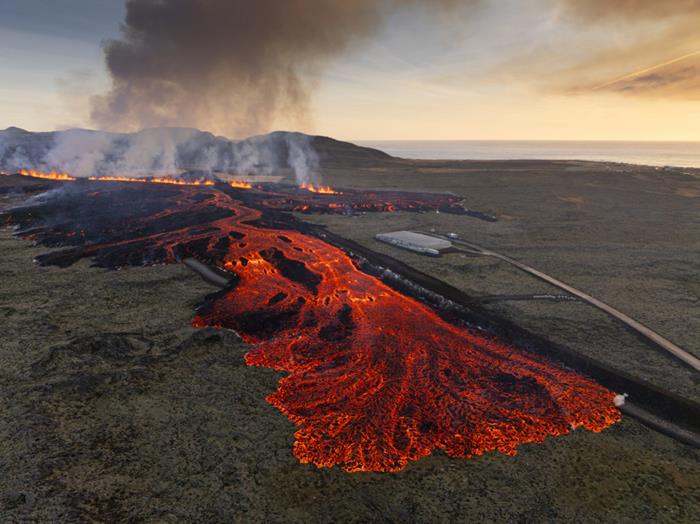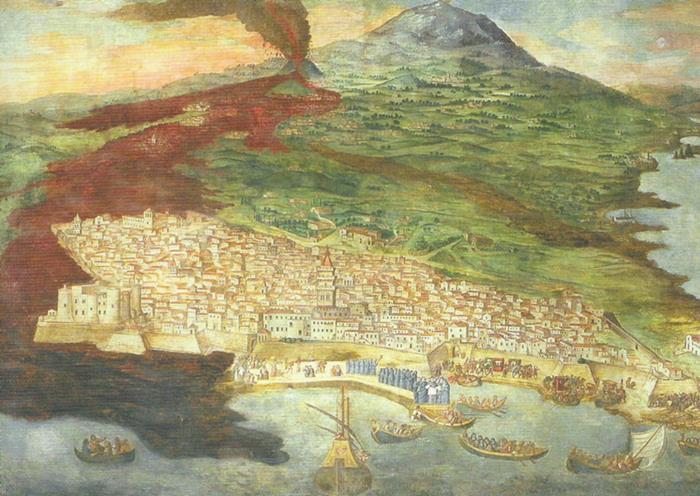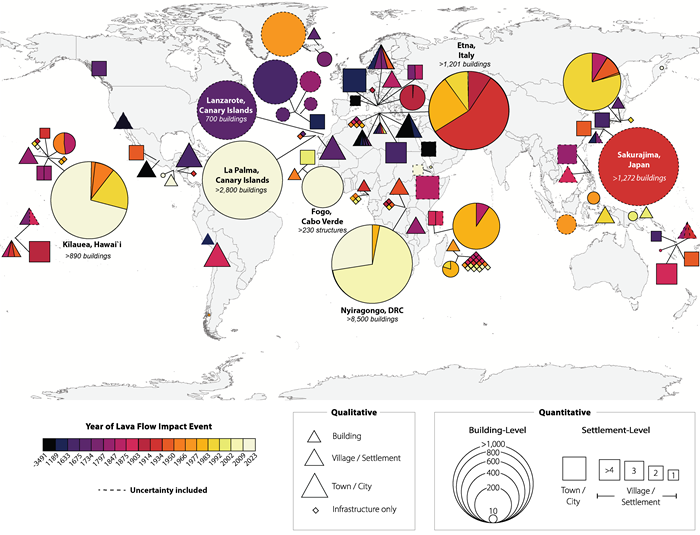This post was authored by Dr Elinor Meredith, a former Research Fellow at the Earth Observatory of Singapore, with Associate Professor Susanna Jenkins as a collaborator. It was edited by Lauriane Chardot and Ethel Pang.
On 14 January 2024, lava flows that weeks before had erupted from the Reykjanes Peninsula, Iceland, entered the town of Grindavík and destroyed homes. Later lava flows impacted geothermal power plant pipelines, causing supply disruptions across the region. In 2021 CE, lava flows from two separate eruptions destroyed thousands of homes in La Palma, Spain, and Goma, Democratic Republic of Congo.
These streams of molten rock are one of the most common volcanic hazards and can be disastrous for communities. Are these impactful events occurring more frequently?

Photograph of lava flows of the Reykjanes Peninsula, Iceland, in January 2024. (Source: Iceland Review)
I recently led a study which explores the frequency and severity of these lava flow impact events. This work, which was published in Journal of Applied Volcanology, was part of my PhD at the Asian School of the Environment and Earth Observatory of Singapore at Nanyang Technological University Singapore.
In our study, we collated and filtered lava flow impact event information from over 300 English-language records. This was a challenge as lava flow impact information is scattered across various forms of literature, newspapers, and other global datasets and sources.
Our new dataset includes 155 events where lava flows have impacted buildings or infrastructure such as roads, ski-lifts, and electricity poles from ~3491 BCE to 2022 CE. Most documented impact events from English-language sources occurred at European volcanoes, with most from Etna volcano in Italy. The most devastating were the 1669 CE lava flows, where part of the city of Catania was destroyed, as well as up to 12 villages.

Depiction of lava flows in 1669 CE from Etna volcano reach the coastal city of Catania, Sicily in Italy by Italian painter Giacinto Platania. (Source: Wikipedia)
However, in recent years, more impact events have been reported at African and Oceanian volcanoes. These regions represent 21% and 8%, respectively, of the impact events recorded in the last 100 years. Strikingly, lava flows at Nyiragongo volcano in the Democratic Republic of Congo have repeatedly impacted the capital city of Goma, destroying thousands of homes in 1977 CE, 2002 CE, and 2021 CE.
We found that the number of lava flow impact events recorded has increased through time with ~ 50% of all impact events recorded within the last 110 years, with approximately seven events per decade.
This increase in recorded events is likely reflecting population growth around volcanoes, which means more people and structures being exposed to lava flows. Approximately 7.6 million people are currently living within 30 kilometres (km) of Nyiragongo, Vesuvius, Etna, Piton de la Fournaise, and Kīlauea, which are volcanoes that have caused damaging lava flows in the past.
The increase in lava flow impact events also likely reflects more recording of these events through time. Damage information from the older events is mostly recorded qualitatively and on a settlement-level scale, based on eye-witness accounts. An example would be these colourful descriptions of the 1783 CE Lakagígar eruption: “the lava advanced over the waterfall […], the fourth and the last lava surge emerged from Skaftá River gorge, with intensive boiling, cracking and clapping, and enormous din, like everything was going berserk” by Jón Steingrímsson, according to this research article.
Damage information from relatively recent events is recorded more quantitatively and on a building-level scale, based on damage assessments from fieldwork or detection using satellite imagery.

This figure depicts the global map of lava flow impact events with corresponding type of data available. Where quantitative data are available, it is represented by circles (data available at the building level), or squares (data available at the settlement level). Where only qualitative data are available, it is represented by triangles. Impacts to infrastructure are recorded in diamonds. Each portion of the icon represents each individual event. The icon is coloured by the year of the impact event, and the size represents the scale of impacts. (Source: Figure 3 from the paper published in Journal of Applied Volcanology)
We found that building-level damage data are particularly important to collect after an impact event, as opposed to settlement-level data. This is because they support volcanologists in understanding the relations between the lava flow, building materials, and the severity of the damage of individual buildings. For example, we found that all of the thatched-roofed-wooden buildings were destroyed during the 1905-1911 CE Matavanu lava flows in Samoa, but the stone churches survived. These findings, if combined with measurements of lava flow thickness, velocities, or temperature, could potentially be used to forecast the damage that might happen during future events.
As populations continue to grow around volcanoes, these impact events will likely continue to affect communities. More impact data collection can help to further understand these events so we can better prepare and reduce the future risk from lava flows.
This research was supported by the Singapore Ministry of Education (MOE) under the Tier 3b project ‘Integrating Volcano and Earthquake Science and Technology (InVEST)’ (award number MOE-MOET32021-0002).